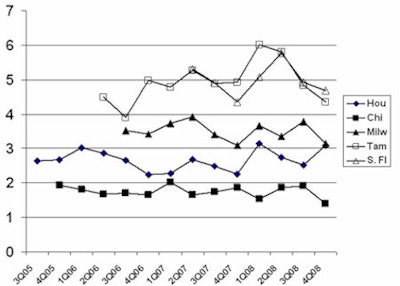
CHICAGO - Radiology benefits management (RBM) firms can help slow the rapid increase in advanced imaging use, in part because of a "gatekeeper effect" that prompts physicians to think twice about ordering exams, according to research presented Wednesday at the RSNA meeting.
In a study that evaluated the effects of RBM HealthHelp's call center decision-support process program on one of its clients, Humana, Dr. David Levin and colleagues at Thomas Jefferson University Hospital in Philadelphia found that HealthHelp saved Humana $8,025,000 in 2008 via use of the program.
Houston-based HealthHelp's decision-support process is three-tiered. In the first tier, requests for exams are taken over the phone by the company's clinical service representatives (CSRs). In 2008, these CSRs took 404,612 requests for MR, CT, PET, and cardiac nuclear medicine studies; 74% of these requests met computerized clinical rules -- based primarily on American College of Radiology (ACR) appropriateness criteria -- and were approved. Of these requests, 1% were not performed and 25%, or 100,487, were referred by the CSRs to the second tier of the process for review by Houston-based HealthHelp clinical coordinators.
In this second phase, 82% of the forwarded requests were approved by the clinical coordinators. Four percent of the forwarded requests were not performed and 2% were dropped, because the ordering doctor failed to call back within 48 hours and confirm the request. Another 2% were changed to a more appropriate procedure, and 10% were sent on to the third tier of the process -- review by a radiologist.
The radiologists approved 65% of the procedure requests after discussion with the ordering physician. Thirteen percent of these third-tier requests were not performed, 16% were dropped, and 4% were changed to a more appropriate procedure. In only 2% of the requests, the ordering physician and the consulting radiologist were unable to reach consensus, Levin said.
"HealthHelp does not deny requests for studies, but they do track it when there is no consensus," he said. "The ordering physician still has the option of getting the study done, but if [the lack of consensus] happens repeatedly, Humana would probably [address the issue with that physician]."
Prior to implementing the program, Humana had been seeing a 10% annual increase in utilizationrate for CT scans and a 45% increase in utilization rate for PET scans, Levin said. After the program was instituted, there was no further increase in either CT or PET use.
 |
| PET utilization rates/1,000 in five large markets after HealthHelp's preauthorization program started. |
 |
| MRI utilization rates/1,000 in five large markets after HealthHelp's preauthorization program started. |
 |
| CT utilization rates/1,000 in five large markets after HealthHelp's preauthorization program started. Images courtesy of Dr. David Levin. |
But over the course of 2008, HealthHelp's decision-support program resulted in 3.3% of requested studies being dropped and another 0.5% changed to a more appropriate study, according to Levin, saving Humana millions of dollars: savings enhanced by the "sentinel effect."
"Just having the three-tier decision-support process in place is a barrier that works to prevent doctors from ordering exams that aren't really necessary," he said.
By Kate Madden Yee
AuntMinnie.com staff writer
December 3, 2009
Related Reading
Putting informatics data to work for decision support, November 30, 2009
MedSolutions report: RBMs could save Medicare $18 billion, July 17, 2009
ACR lobbies against RBMs, utilization rate changes, June 26, 2009
Could decision-support software help radiologists fend off RBMs, April 7, 2009
Decision-support software cuts imaging procedure volume, March 24, 2009
Copyright © 2009 AuntMinnie.com




















